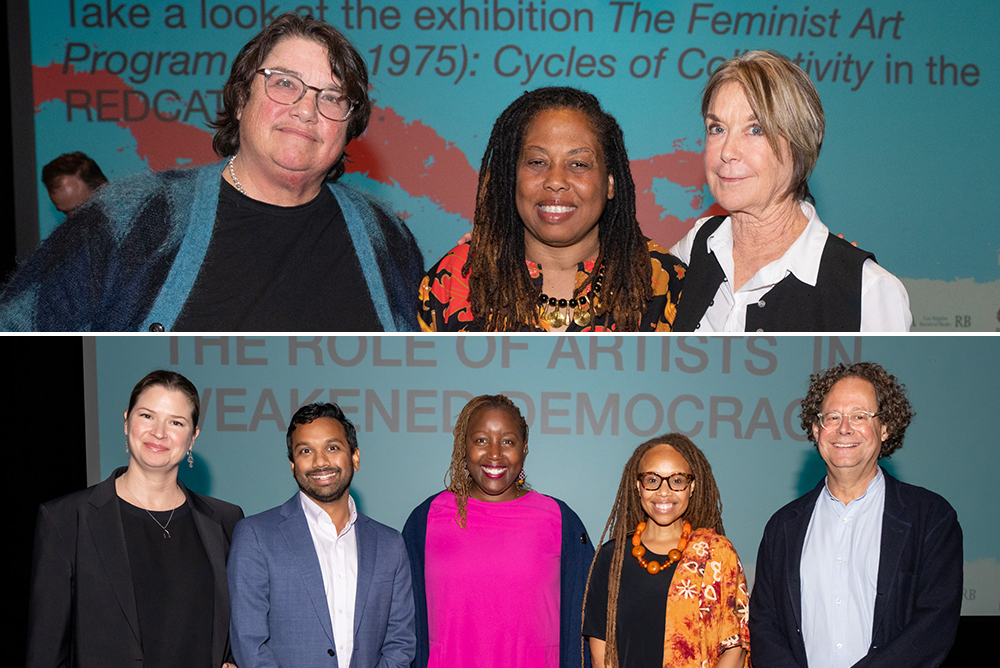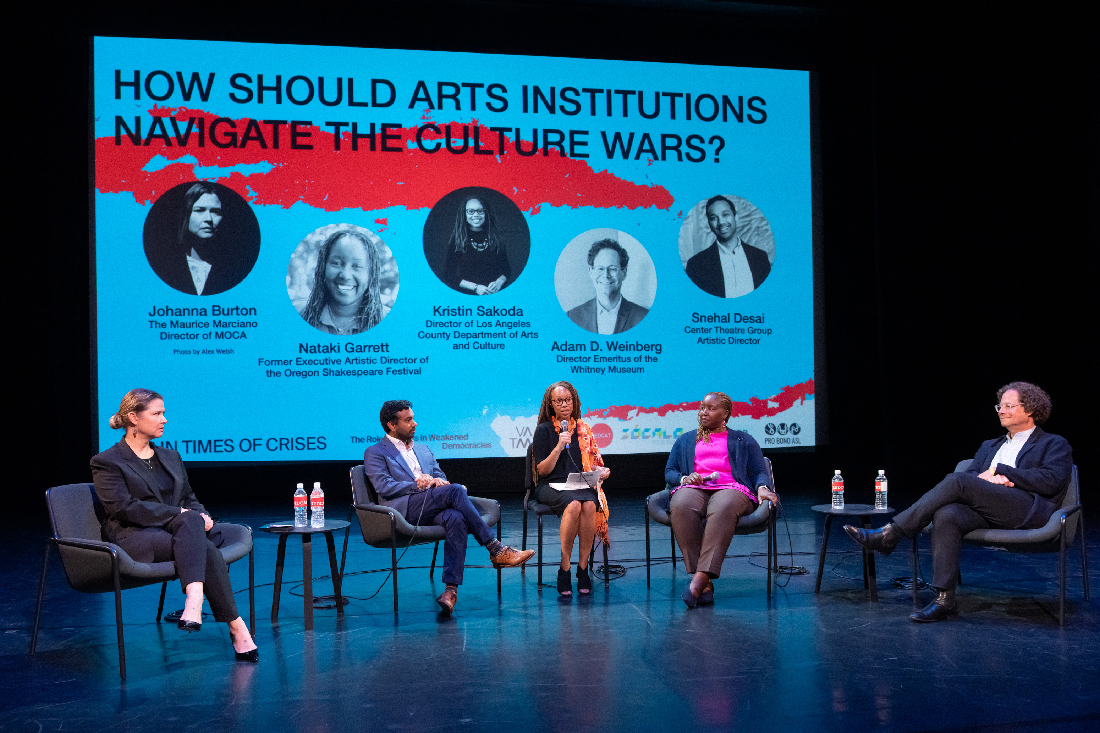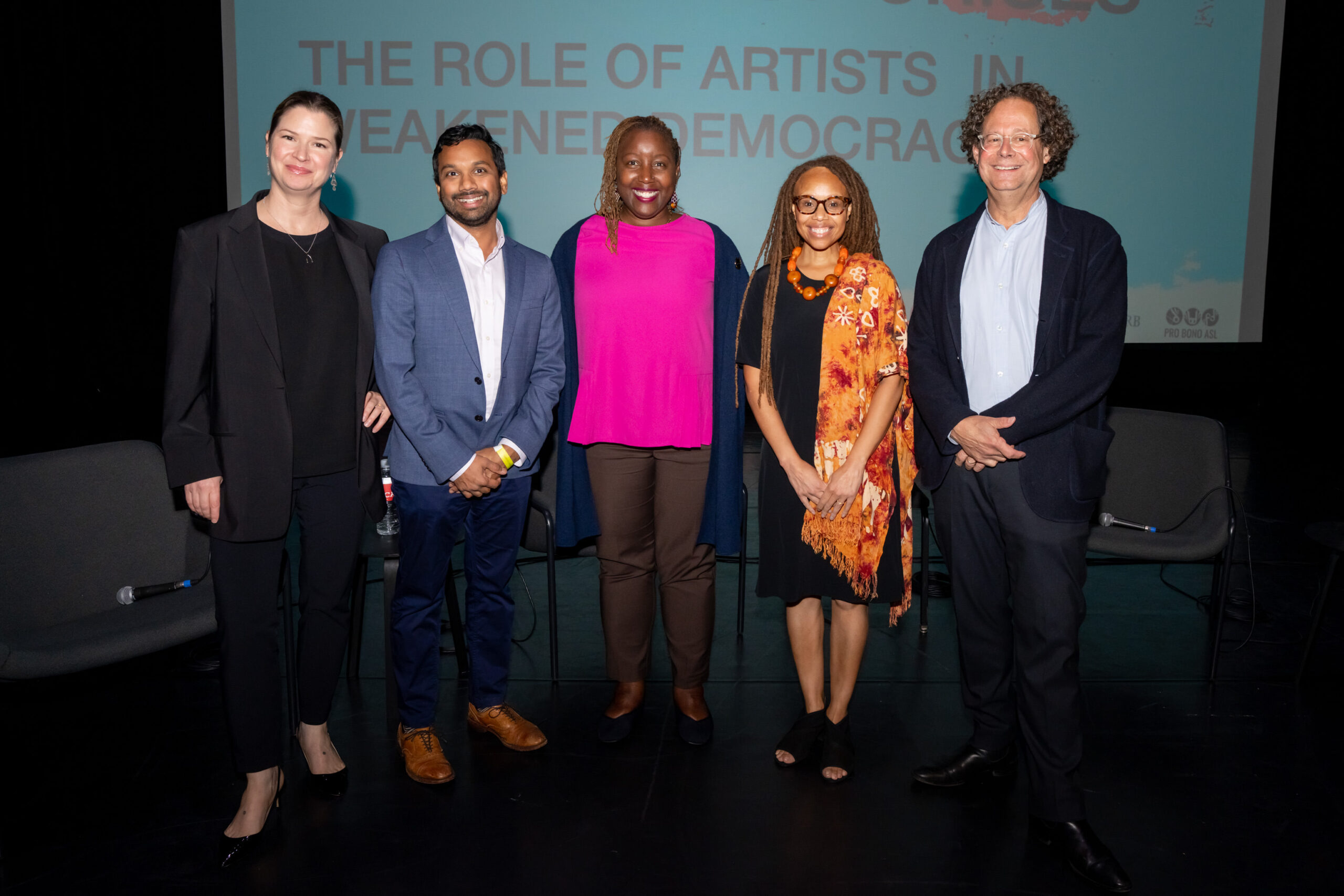
Top, from left to right: Catherine Opie, Karen Mack, and Suzanne Lacy. Bottom, from left to right: Johanna Burton, Snehal Desai, Nataki Garrett, Kristin Sakoda, and Adam D. Weinberg.
Leading voices in the arts from around the world convened in Los Angeles recently to take part in “Arts in Times of Crises,” a two-day conference on the role of artists in weakened democracies put on by the Villa Aurora Thomas Mann House (VATMH).
Zócalo was one of the co-hosts, alongside REDCAT and the Los Angeles Review of Books, and as part of the conference presented two public panels. Both explored how, in polarized times, artists and civic leaders can bridge divides and tap into our shared humanity—but only if they’re able to ask questions and stage their work without censure from narrow discourse or institutional might.
Social-practice artist Suzanne Lacy and photographer Catherine Opie took part in the first panel, which asked, “Must Artists Be Activists?” Karen Mack, founder and executive director of LA Commons, moderated.
To get things started, Lacy read aloud the definition of activism—”a doctrine or practice that emphasizes direct vigorous action, especially in support of or opposition to one side of a controversial issue.” She called attention to buzzwords that jumped out to her: “direct,” “opposition,” and “one side.”
“I’ve done some of that work,” Lacy said, “but I’m much more interested in educational strategies and in coming together and working out difference.” She shared that she sees a clear delineation between activist work she takes on “as a citizen” and work she does “as an artist” where she is, above all, trying to “make meaning, understand, and ask questions.”
Opie offered a similar sentiment: “At times when I don’t have a camera on me, and I’m at a march, there is a moment that maybe I’m an activist,” she said. “But whenever I have a camera on me, I’m no longer that same kind of activist because I’m bearing witness, and I’m really looking at the world from my own questions that I’m trying to answer.”
During the conversation, Mack asked the panel, as educators, how they “cultivate this next generation” of artists and activists in today’s polarizing times.
Lacy, who is a professor at the Roski School of Art and Design at the University of Southern California, said she makes a point of inviting a community organizer to speak to her classes. Arts schools need to incorporate such voices, she argued. My students, she said, “have great compassion. They want to act. They understand critical theory. But they don’t know how to build coalition.”
Opie lamented the pandemic’s impact on students today. Young people are struggling with how to have real dialogue “without prosecution,” she said. Having recently retired from UCLA after 25 years, Opie expressed a desire to spend more time with grade school students in L.A., helping them bridge sharpened divides. “I’m really concerned with what social media has done to our culture and our world and our ability for speech,” she said.
After a coffee break, the next panel took the stage: a roundtable, featuring artistic director at large Nataki Garrett, Center Theatre Group artistic director Snehal Desai, MOCA director Johanna Burton, and Whitney Museum director emeritus Adam D. Weinberg. The moderator was Kristin Sakoda, director of Los Angeles County Department of Arts and Culture.
Tasked to answer “How Should Arts Institutions Navigate the Culture Wars?,” they talked about the potential for cultural institutions going forward to create connection in contentious times.
The panel began by discussing how they bridge difference in their institutions—from fostering a sense of community among their own employees to making sure that visitors feel welcome in their space.
Weinberg spoke about trying to make all employees feel like they had a stake in his institution—”not just the artistic people” but also the engineers and maintenance people.
Burton prioritized listening: “What space do we produce not only where we teach the audiences that come into our institutions but we learn in turn?”
Desai said that he works to feature voices who can share non-dominant perspectives and stories.
And Garrett said that she looked after the most vulnerable first: “From my experience when you’re serving the most vulnerable then everybody gets served,” she said. “When you’re serving the most privileged, they’re the only ones who get served.”
The panel also discussed the merits of “building” versus “fixing” at an institutional level.
“Are agents of change able to work within the systems of arts as we have them now? Or must we change the system to make change?” Sakoda asked. She noted that today cultural institutions are appointing more women and people of color to leadership positions than ever before. However, after such “high-profile announcements,” often, just a few years later, she’ll read about “quiet exits” that come with a “sense that the person’s vision or their change agenda was not always supported.”
It’s hard to talk in generalities, said Weinberg, as “each situation has to be taken and molded around the conditions of that community, that institution, its history and past.” He equated his job to that of a potter—tearing and building again and again.
But some patterns persist across the board, said Garrett. “As a Black woman leader, I’ve never been appointed to a position where I didn’t have to clean up the job coming in.” Which is why, she said, it’s important in “these moments of sea change” to consider whether when a woman, and a Black woman in particular, is offered such a position, whether the system she’s entering is set up to support her and her vision. Those taking over embattled institutions need to consider: Are the constituencies that brought you on board open to change? And are they prepared to support whatever it takes to clean up the operation?
“There’s a rite of passage for certain right-wing blogs,” said Desai, that “when you come into these positions, they want to nail you.” When he started at CTG, he added, interviewers always asked: “Is your program going to be woke? Are you going to be politically correct?” The reason? “They want to brittle the divide between you and the community you’re trying to create,” he argued. “That’s what needs to be called out.”
“Our panel is about navigating the culture wars,” said Sakoda. How do you feel that manifests today?
Desai spoke about the problems of the binary. “So much of human existence is about a gray area,” he said. “When you say ‘war’ you have factions and you have a winner and a loser. You’re set up in a way where someone’s going to win and someone’s going to lose.” Compromise, and a willingness to come to the table, should be seen as signs of strength, not weaknesses, he argued.
Weinberg nodded to his privilege as a white man and noted that even given that, he found it difficult to make change at an institutional level. “I was director of the Whitney for over 20 years,” he said, and it took him a decade to start feeling like he was making meaningful headway in the work.
“I do have a strong sense of promise in institutions and the role of the public sector in supporting the arts,” Sakoda said, noting that she’s coming up on marking 15 years as a leader in the public sector for arts. She asks panelists what promise they see in arts and culture institutions.
“The promise of institutions might be to work differently—not only within our own institutions but with each other, and I do think it’s possible,” said Burton.
Desai shouted out Garrett’s Professional Non-Profit Theatre Coalition, which makes the case that theater, like other civic institutions, provides a public good by promoting dialogue and working “to humanize the troubles that are ailing us.” This is how we find common points of connection, he said.
Before the discussion wrapped, panelists also offered young leaders advice on how to work with their boards, who might have different visions and agendas for the institution.
“You have to be prepared to be in a dialogue on the things you’re trying to do together,” said Garrett.
“Get to know each board member,” said Weinberg.
“Know yourself and your brand and your True North,” said Desai. “It’s a dialogue and conversation, but you have to know where the line is without compromising yourself.”
Sakoda agreed. “Know your vision. Steward what you have.”
“Other than that,” Weinberg said with a smile, “it’s all very easy.”






Send A Letter To the Editors